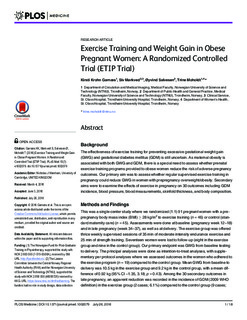| dc.description.abstract | Background:
The effectiveness of exercise training for preventing excessive gestational weight gain (GWG) and gestational diabetes mellitus (GDM) is still uncertain. As maternal obesity is associated with both GWG and GDM, there is a special need to assess whether prenatal exercise training programs provided to obese women reduce the risk of adverse pregnancy outcomes. Our primary aim was to assess whether regular supervised exercise training in pregnancy could reduce GWG in women with prepregnancy overweight/obesity. Secondary aims were to examine the effects of exercise in pregnancy on 30 outcomes including GDM incidence, blood pressure, blood measurements, skinfold thickness, and body composition.
Methods and Findings:
This was a single-center study where we randomized (1:1) 91 pregnant women with a prepregnancy body mass index (BMI) ≥ 28 kg/m2 to exercise training (n = 46) or control (standard maternity care) (n = 45). Assessments were done at baseline (pregnancy week 12–18) and in late pregnancy (week 34–37), as well as at delivery. The exercise group was offered thrice weekly supervised sessions of 35 min of moderate intensity endurance exercise and 25 min of strength training. Seventeen women were lost to follow-up (eight in the exercise group and nine in the control group). Our primary endpoint was GWG from baseline testing to delivery. The principal analyses were done as intention-to-treat analyses, with supplementary per protocol analyses where we assessed outcomes in the women who adhered to the exercise program (n = 19) compared to the control group. Mean GWG from baseline to delivery was 10.5 kg in the exercise group and 9.2 kg in the control group, with a mean difference of 0.92 kg (95% CI −1.35, 3.18; p = 0.43). Among the 30 secondary outcomes in late pregnancy, an apparent reduction was recorded in the incidence of GDM (2009 WHO definition) in the exercise group (2 cases; 6.1%) compared to the control group (9 cases; 27.3%), with an odds ratio of 0.1 (95% CI 0.02, 0.95; p = 0.04). Systolic blood pressure was significantly lower in the exercise group (mean 120.4 mm Hg) compared to the control group (mean 128.1 mm Hg), with a mean difference of −7.73 mm Hg (95% CI −13.23, −2.22; p = 0.006). No significant between-group differences were seen in diastolic blood pressure, blood measurements, skinfold thickness, or body composition in late pregnancy. In per protocol analyses, late pregnancy systolic blood pressure was 115.7 (95% CI 110.0, 121.5) mm Hg in the exercise group (significant between-group difference, p = 0.001), and diastolic blood pressure was 75.1 (95% CI 71.6, 78.7) mm Hg (significant between-group difference, p = 0.02). We had planned to recruit 150 women into the trial; hence, under-recruitment represents a major limitation of our results. Another limitation to our study was the low adherence to the exercise program, with only 50% of the women included in the intention-to-treat analysis adhering as described in the study protocol.
Conclusions
In this trial we did not observe a reduction in GWG among overweight/obese women who received a supervised exercise training program during their pregnancy. The incidence of GDM in late pregnancy seemed to be lower in the women randomized to exercise training than in the women receiving standard maternity care only. Systolic blood pressure in late pregnancy was also apparently lower in the exercise group than in the control group. These results indicate that supervised exercise training might be beneficial as a part of standard pregnancy care for overweight/obese women. | nb_NO |

